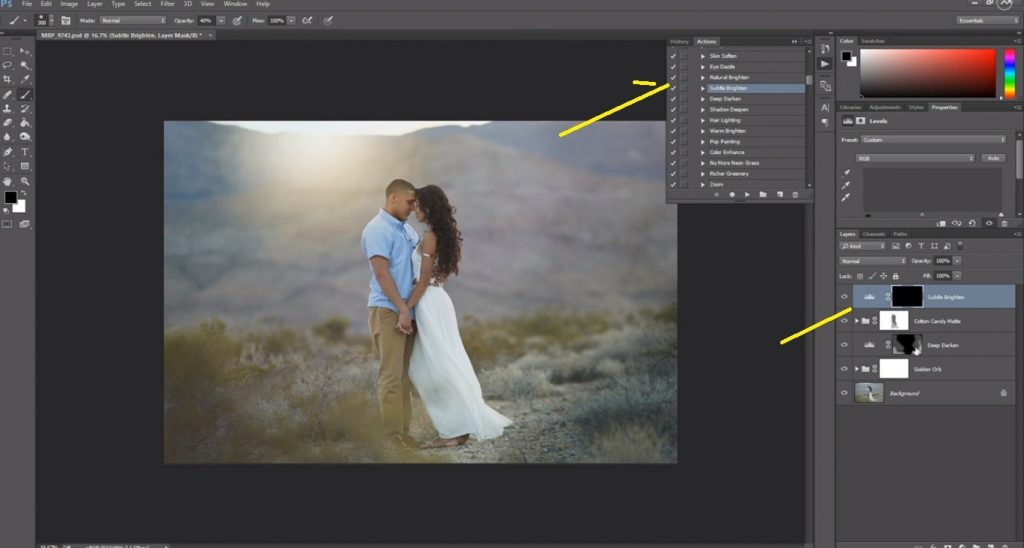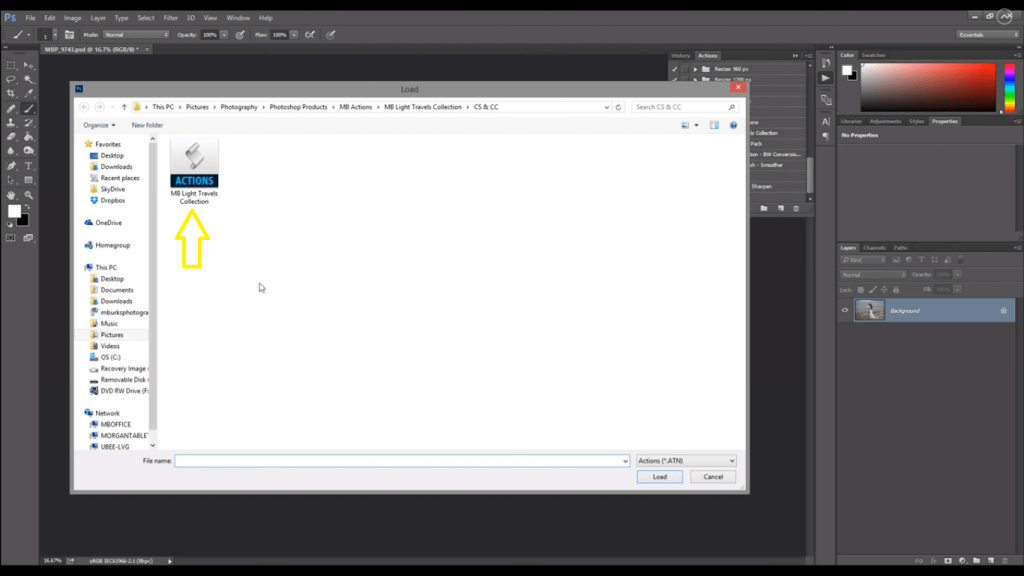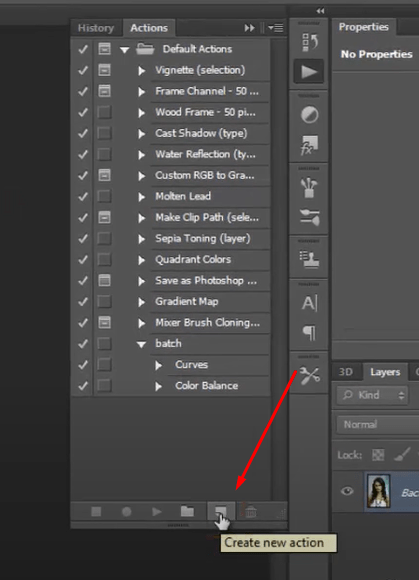Photoshop Quick Actions are a series of pre-recorded steps that can be applied to an image or design project to speed up workflow and streamline the editing process. Quick Actions can be applied to a single image or multiple images at once, saving time and effort in repetitive tasks such as resizing, applying filters, color grading, or adding effects.
Photoshop Quick Actions can be created, saved, and shared among designers, making them a valuable asset for both professionals and beginners in graphic design. They allow for customization, allowing users to record and modify their own actions or download and install actions created by others.
Quick Actions are easily accessible through the Actions panel in Photoshop, which displays a list of actions that can be applied with just a single click. Users can also organize their actions into sets, making it easier to locate and apply specific actions for a particular project.
Photoshop Quick Actions are a powerful tool for designers looking to increase their productivity, minimize repetitive tasks, and enhance the creative possibilities of their work.
Different Types of Quick Actions
There are several different types of Quick Actions that can be created and used in Photoshop. Here are some of the most common types:
- Basic Adjustments: These actions are designed to make basic adjustments to an image, such as adjusting the brightness, contrast, or saturation levels.
- Color Correction: These actions can help correct color issues in an image, such as white balance or color cast problems.
- Effects: Actions that apply a variety of effects, such as filters, textures, and styles, to an image with just one click.
- Workflow: These actions are designed to speed up the overall workflow in Photoshop, such as creating a new layer, duplicating a layer, or flattening an image.
- Batch Processing: Actions that can be applied to multiple images at once, which can be a massive time-saver for tasks like resizing, watermarking, or renaming images.
- Social Media: Actions designed specifically for social media platforms, such as creating optimized images for Facebook or Instagram.
- Creative Editing: Actions that apply unique and creative edits to an image, such as vintage, film, or light leak effects.
The type of Quick Action you use will depend on the specific task you are trying to accomplish and the overall creative vision for your project. By having a range of Quick Actions at your disposal, you can speed up your workflow and enhance the creative possibilities of your work.
Benefits of Using Quick Actions
There are numerous benefits to using Quick Actions in Photoshop, including:

- Increased Efficiency: Quick Actions allow users to complete repetitive tasks in a fraction of the time it would take to perform the same steps manually.
- Consistency: Quick Actions can help ensure consistency in your designs, as the same actions can be applied consistently across multiple images or projects.
- Customization: Quick Actions can be customized to meet your specific needs, allowing you to tailor actions to your particular workflow or style.
- Creativity: Quick Actions can inspire creativity by allowing users to experiment with different effects and adjustments quickly and easily.
- Speed: Quick Actions can help speed up your workflow by allowing you to complete tasks faster and move on to other projects more quickly.
- Accuracy: Quick Actions can help reduce errors and mistakes, as they can be pre-recorded and applied consistently across multiple images.
- Collaboration: Quick Actions can be shared with others, making it easier to collaborate with team members or share actions with others in the design community.
Quick Actions can be a powerful tool for enhancing productivity, creativity, and collaboration in Photoshop. By using Quick Actions, designers can save time, increase efficiency, and take their designs to the next level.
How to Set Up Quick Actions
Setting up Quick Actions in Photoshop is a straightforward process. Here’s a step-by-step guide:
- Open the Actions Panel: Go to the “Window” menu and select “Actions” to open the Actions panel.

2. Create a New Action: Click on the “Create new action” button at the bottom of the Actions panel. Give your action a name and assign it to a set, if desired.

3. Record Your Action: Click the “Record” button to start recording your action. Perform the steps you want to include in your action, such as adjusting levels or applying filters.
4. Stop Recording: Click the “Stop” button to stop recording your action.
5. Test Your Action: Play your action by clicking the “Play” button to test it out. Make any necessary adjustments or modifications to your action.
6. Save Your Action: Click the “Save” button to save your action. It will now be available in the Actions panel for future use.

7. Create More Actions: Repeat the process to create additional Quick Actions as needed.
Once you have created your Quick Actions, you can use them by simply selecting the action you want to apply in the Actions panel and clicking the “Play” button. You can also assign keyboard shortcuts to your actions for even faster access. By creating and using Quick Actions, you can speed up your workflow and streamline your editing process in Photoshop.
How to Use Quick Actions
Using Quick Actions in Photoshop is a simple process. Here’s a step-by-step guide:
- Open the Actions Panel: Go to the “Window” menu and select “Actions” to open the Actions panel.
- Select an Action: Choose the Quick Action you want to use from the Actions panel.
- Play the Action: Click the “Play” button to run the action. Photoshop will automatically perform the steps included in the action.
- Modify the Action: If you want to modify the action, simply select the action in the Actions panel and click the “Record” button. Make the changes you want, and then click “Stop” to save the new version of the action.
- Assign a Keyboard Shortcut: To speed up your workflow. You can assign a keyboard shortcut to a Quick Action. Select the action in the Actions panel, then click the “Options” button and choose “Insert Menu Item.” Type in the keyboard shortcut you want to use, then click “OK” to save it.
By using Quick Actions in Photoshop, you can streamline your workflow and save time on repetitive tasks. Whether you are adjusting levels, applying filters, or performing other edits, Quick Actions can help you work more efficiently and effectively. Try out different actions and experiment with customizing them to meet your specific needs. With Quick Actions, you can take your Photoshop skills to the next level.
Read More: Outsourcing Photoshop Editing Services
YouTube video tutorial on using Photoshop actions
Final Thoughts on Photoshop Quick Actions
Photoshop Quick Actions are a powerful tool that can help you speed up your workflow and achieve professional-quality results in less time. With Quick Actions, you can automate repetitive tasks, apply multiple edits with a single click, and even create your own custom actions to suit your specific needs.
One of the greatest benefits of Quick Actions is their ability to streamline your editing process. By automating tasks such as adjusting levels, resizing images, or applying filters, you can work more efficiently and focus on the creative aspects of your work.
Moreover, Quick Actions can help you maintain consistency across multiple images or projects. By applying the same edits to multiple images with a single click, you can ensure that all of your work has a cohesive look and feel.
In conclusion, Quick Actions are an essential tool for any Photoshop user looking to work more efficiently and effectively. Whether you are a professional photographer, graphic designer, or digital artist, Quick Actions can help you take your work to the next level and achieve stunning results in less time.
Frequently asked questions about Photoshop Quick Actions
-
What are Photoshop Quick Actions?
Quick Actions are pre-recorded series of steps in Photoshop that can be applied to an image or set of images with just a few clicks. They can be used to automate repetitive tasks, apply multiple edits at once, and speed up the editing process.
-
Why aren’t my Photoshop Quick Actions showing up?
There could be several reasons why your Quick Actions are not showing up in Photoshop. Firstly, make sure that your Actions panel is visible by going to the “Window” menu and selecting “Actions”. If the panel is visible but the Quick Actions are still not showing, try resetting your Photoshop preferences by holding down Alt+Control+Shift (Windows) or Option+Command+Shift (Mac) as you start Photoshop. You may also want to check the file format you are using, as some Quick Actions may only be compatible with specific file formats. If the Quick Action is loaded but not working properly, check the Actions panel for any error messages and troubleshoot or edit the action as needed.
-
How do I create my own Photoshop Quick Actions?
To create your own Quick Actions, simply record a series of steps in Photoshop using the Actions panel, and then save them as an action. You can then apply this action to other images in the future.
-
Can I download Quick Actions created by other people?
Yes, there are many websites and online communities where users can share and download Photoshop Quick Actions. It’s important to make sure you trust the source of the actions and scan them for viruses before installing them on your computer.
-
Are Photoshop Quick Actions compatible with all versions of Photoshop?
Quick Actions are compatible with most versions of Photoshop, although some older versions may not support certain features. It’s always a good idea to check the compatibility of any Quick Actions you download or create before attempting to use them







